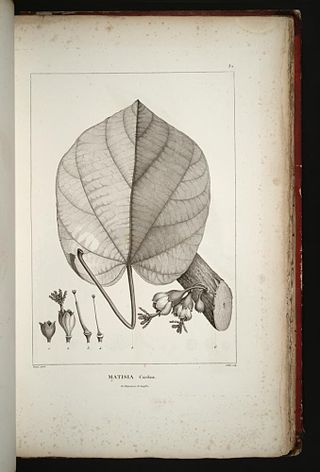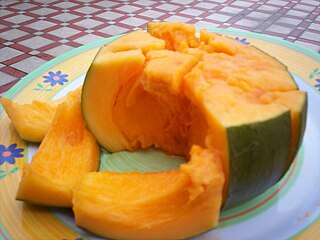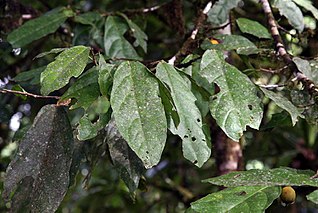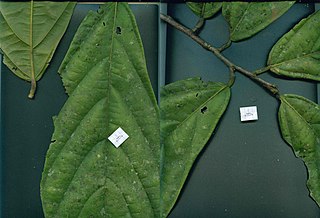
The International Union for Conservation of Nature (IUCN) Red List of Threatened Species, also known as the IUCN Red List or Red Data Book, founded in 1964, is an inventory of the global conservation status and extinction risk of biological species. A series of Regional Red Lists, which assess the risk of extinction to species within a political management unit, are also produced by countries and organizations.

A swizzle stick is a small stick used to stir drinks. The original swizzle sticks were created in the 18th century at a rum plantation in the West Indies using the branch of the Quararibea turbinata. In the late 19th and early 20th centuries, stir sticks made of glass were created to shake out the bubbles from champagne, whose carbonation caused indigestion for some drinkers.

The brown-eared woolly opossum, also known as the western woolly opossum, is an opossum from South America. It was first described by German naturalist Ignaz von Olfers in 1818. The opossum is characterized by a brown to reddish brown coat and similarly colored limbs, yellow to orange underbelly, hairless, brown ears with a hint of pink, and a tail furred on the back for up to half of its length. The brown-eared woolly opossum is nocturnal, solitary and omnivorous. The IUCN lists it as least concern.

The dark long-tongued bat is a species of bat from South and Central America. It was formerly considered the only species within the genus Lichonycteris, but is now recognized as one of two species in that genus, along with the pale brown long-nosed bat. It is small species of bat, with adults weighing 6–11 g (0.21–0.39 oz) and having a total length of 46–63 mm (1.8–2.5 in).

Quararibea cordata, the South American sapote or chupa-chupa, is a large, semi-deciduous, fruit tree, native to Amazon rainforest vegetation in Brazil, Colombia, Ecuador, and Peru. It bears orange-yellow fruit which are soft, juicy, sweet and contain 2-5 seeds. Fruit is usually eaten out of hand, though it may be juiced.

Quararibea is a genus of flowering plants in the family Malvaceae.

The green-bellied hummingbird is a species of hummingbird in the "emeralds” tribe Trochilini of subfamily Trochilinae. It is found in Colombia and Venezuela.

Quararibea aurantiocalyx is a species of flowering plant in the family Malvaceae. It is found in Costa Rica and Panama. It is threatened by habitat loss. It usually grows in the wet tropical biome.
Quararibea dolichopoda is a species of flowering plant in the family Malvaceae. It is found only in Panama. It is threatened by habitat loss.

Quararibea dolichosiphon is a species of flowering plant in the Malvaceae family. It is found only in Panama. It was first published in Bull. Jard. Bot. Natl. Belg. 40: 353 (1970) by A.Robyns & S.Nilsson.
Quararibea gomeziana is a species of flowering plant in the family Malvaceae. It is found in Costa Rica and Panama. It is threatened by habitat loss.
Quararibea jefensis is a species of flowering plant in the family Malvaceae. It is found only in Panama. It is threatened by habitat loss.
Quararibea pendula is a species of flowering plant in the family Malvaceae. It is found in Costa Rica and Panama. It is threatened by habitat loss.

Quararibea platyphylla is a species of flowering plant in the family Malvaceae. It is found in Costa Rica and Panama. It is threatened by habitat loss.
Quararibea pterocalyx, the wild palm or cinco dedos, is a species of flowering plant in the family Malvaceae. It is found in Colombia, Costa Rica, Panama, and Venezuela. It is threatened by habitat loss.
Quararibea sanblasensis is a species of flowering plant in the family Malvaceae. It is found in Colombia and Panama. It is threatened by habitat loss.
Quararibea santaritensis is a species of flowering plant in the family Malvaceae. It is found only in Panama.
Quararibea velutina is a species of flowering plant in the family Malvaceae. It is found only in Peru.
Piper truman-yunckeri is a species of plant in the family Piperaceae. It is endemic to Ecuador.

ʻEua National Park is a national park on the island of ʻEua in Tonga. It is the country's only national forest park and covers an area of 4.51 km2 (2 sq mi). The park is located on the east coast of the island and covers an 800 metres (2,625 ft) band of tropical rainforest and is bordered on the west by sheer cliffs to the ocean, which have numerous caves and chasms. It received national park status in 1992. The area is protected by IUCN.











